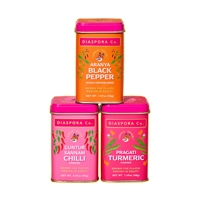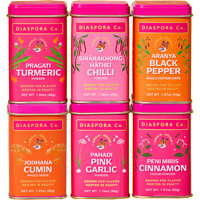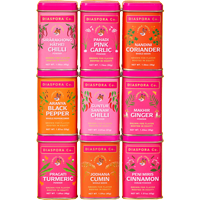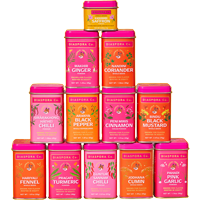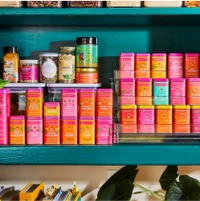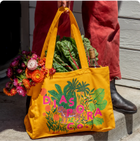Nestled behind a large highway and quickly urbanizing landscape are Kashmir’s ancient saffron fields. Pampore, or ‘saffron town’ as it is better known, was once a lush plateau awash with the purple crocuses that yield the fragrant spice. Many legends speak about travelling Sufi saints who gifted a local chieftain a bulb of the luxurious spice; others mention how Abu Fazl, the noted historiographer at emperor Akbar’s court, noticed how the fields could please even the most serious and disgruntled — like their beloved king.
But today, Kashmiri saffron, called ‘Kungposh’ in the local language, is a dwindling treasure. Fierce competition with high-yielding saffron from Iran, lack of incentives from state and central governments, militarisation, violence and climate change — these are only some of the challenges the spice faces. In August 2019, the Indian government abrogated Article 370 (and 35a), a constitutional feature that guaranteed Kashmir separate statehood, a separate flag and limited legislative autonomy under the Indian government. The abrogation was executed without consent from Kashmiris, and resulted in anxiety, political upheaval and a change in the region’s land laws, which enabled the complete control of Kashmir’s land by the BJP government, led by Prime Minister Narendra Modi.
But amid all this, Raqib Mushtaq, Diaspora Co’s supplier of the spice, is determined to grow heirloom saffron, and make sure it survives. Like almost half of the population in Pampore, Raqib belongs to a family of saffron farmers and traders. Since he was a young boy, he remembers days marked by the fragrance of saffron, songs of harvest and how the community would come together to farm this beautiful, delicate resource from their lands.
We speak to Raqib about farming the spice, differences between Kashmiri and Iranian saffron, starting his business during the pandemic, and the challenges he faces due to militarization in India-administered Kashmir.
![]()
SD: The first time I encountered Kashmiri saffron was here, in this room. And I remember thinking that I had not smelled anything like it before. Even though I had encountered saffron in rituals, or in some food, it wasn’t like this aroma that came wafting through these doors.
RM: I remember that as well. We infused a few strands in a small bucket of warm water to show you how it smells. The color of Kashmiri saffron is very specific. It is a ‘bloody red’, but it also glistens like gold. It is not the yellow color that it is often associated with in parts of the Indian mainland. Neither is it the tart-orange that people often think it is. Also, as you said, it has a wafting aroma. It isn’t a punchy smell, like its Iranian counterpart. It is sweeter, heavier, and more robust.
SD: It was almost like being almost enveloped by it slowly, like a mist. I want to ask you more about these specific qualities of Kashmiri saffron, but first, tell me — how did you get started in this business?
RM: I was born into the trade. Like many families in Pampore, mine has been farming saffron for a very long time, and I have been surrounded by the spice for my whole life. My grandfather started off trading in the spice, but he would also grow some on a small scale. But my father decided to concentrate on trading. When I got older, I wanted to continue working with saffron but in a more involved way. I decided I needed to be part of the whole process: farming, processing and selling. Kashmiri saffron is a special, unique thing, it is not something one can dabble with in haste.
SD: How did you want to do things differently?
RM: Well, my father had a set of clients that he used to sell the spice to and they would package it. But he had little control over the quality of the eventual product, and there wasn’t much emphasis on contextualizing the spice, introducing the customer to its culture, and creating a community around it.
So I knew from the beginning that my trajectory would be different. For one, I want to sell directly to customers and clients as well, [and] not submit to any mercenary middlemen. Because of the pressure on farmers, in recent years, there was a lot of adulteration. I knew I would never do [that], even in dire times. The saffron I want to grow is pure Kashmiri saffron, cultivated without chemicals and sold without any faking. It is saffron of blood-red strands and the sweetest smell.
SD: I have heard people say “saffron belongs to Pampore”. There is an automatic, metaphorical connection of the spice to the land. Why is that?
RM: I think they say that because of the kind of land formations we have here in Pampore, and in other places like Lethopora. It is a [mineral] deposit known as Karewa, which we also call ‘vudr’ in our language. These are lacustrine deposits from lakes, formed thousands of years ago. They have a higher content of crocin – a carotenoid pigment that gives saffron its unique colour, and also nourishes its medicinal value. The soil of Karewas is not just integral but also essential for Kashmiri saffron to grow. It is a sort of ‘kismet’ then that saffron is here. This is why so many of our elders will say it is divine intervention, and [that] this soil has a lot to do with the brilliant quality of the saffron in Kashmir.
SD: Every season is important for the crop, is this right? Could you take me through the crop cycle of a saffron crop?
Yes, that’s right. We are on a plateau, and the seasons Pampore gets include heat, rain and cold. These are all integral. We transplant and sow the seeds —which in the case of saffron are called ‘corms’ — in September. Pampore is not a flat piece of land and there are ups and downs, so we grow the crop on elevated land surrounded by ‘nariyan’ or channels that keep moisture from flooding the land. In October, the flowering begins. Typically, between October 20 and November 1 is the peak of when the flowers emerge. We collect them and store them properly — if you keep them all together, they will spoil — and begin processing.
But before we get into that, through the year, the land is dug for aeration. It has to be elevated, and the moisture level in the soil needs to be monitored. Also, the saffron corm is a curious one; the leaves come on it after the flowers. We let the leaves be through the winter, and allow the corms to settle and multiply in the soil. After snowfall, we begin to treat the land for the next cycle of the crop, transplant it, and make sure its moisture content is right. A good snowfall is important; it is the snow that moistens the soil in moderation.
SD: And the processing — what does that entail?
RM: Kashmiri saffron is processed entirely by hand. Many will say it competes with Iranian saffron. But this is not a realistic competition, as the quantities that Iran produces are very large. Also, the processing of saffron there is standardised, supervised and mechanised. Here, we don’t have any kind of mechanical infrastructure to grow the spice, so the seed is the one from the previous cycle, the process is entirely organic and natural, and the saffron is hand-plucked and sorted. But also, because of the hand-plucking, the strands retain weight, oil and aroma.
When the plucking begins, the red part, from which saffron is derived, is removed from the flower. It is also separated from the yellow strand, which is the male part of the flower, and not considered a part of the spice. The red saffron strand also has a tail, so we have to dry it, moisten it again so it doesn’t break and then slowly remove the tail. This tail-less red part or ‘mongra’ is first-grade, pure Kashmiri saffron. However, these processes are not always respected. For example, the yellow strand or ‘zarda’ is often packaged along with pure saffron, or colored and passed off as pure saffron through second-hand channels. But this isn’t right — the highest grade of pure saffron, which is what is sold by Diaspora Co., is carefully separated from the other bits of the flower. Its smell and medicinal quality is unique and irreplicable.
SD: It sounds complicated. Is it?
Yes, it is a delicate process, which involves lots of care and training. It is not just important to create a base aroma. We also concentrate on the way the aroma must approach the person using the spice, in a meandering way; the weight of the spice, the feeling of it. This ‘cloak’ you described earlier. These are difficult tasks, yes, but also ones that give us great joy. I remember as a young boy, this time [of processing] as one of the best. My father even said I was a natural at processing. When I was 10 years old, I would try my hand at techniques and was praised for being adept at them.
SD: It's more than just the hand-plucking that makes it different from Iranian saffron. How can customers distinguish?
I understand when people are confused about this, because saffron is almost automatically associated with Iran. So people think – why is Kashmiri saffron so exclusive or expensive, when the same spice costs much less in Iran? But the differences are many. For one, the hand plucking does render a specific quality to the saffron. There is a ‘finish’ that is different when we remove the tail. The strand is heavier, oilier, and has more ash content. But what is most crucial is Kashmiri saffron’s crown, or ‘taj’. The strand has a flattened head that holds oil and it is where the aroma is released from. The taj is crucial to purest Kashmiri saffron.
Kashmiri saffron is also heavier. If you take 1 gram of Kashmiri saffron in one hand, and 1 gram of Iranian saffron in the other, you’ll see that the Kashmiri saffron threads are fewer – say 250 threads, compared to some 350 threads of the Iranian saffron. Because it is heavy, the flavour is denser-bodied, and can also be used more frugally. And there is the colour. Kashmiri saffron is the ‘bloody’ hue we spoke about, while Iranian saffron tends to be pink-ish. The colours are certainly not the same.
SD: There are challenges here, right? To actually be able to push Kashmiri saffron into the international market is not easy?
Kashmiri saffron cannot match the Iranian kind in yield, and suffers from the quantity-centric mindsets of today’s purchasers. It is not important to have a lot of Kashmiri saffron. Infusion is also a thing of care and patience. The gifts of Kashmiri saffron lie in its details, and delicate properties.
But that aside, there is also the lack of infrastructure within Kashmir. The world is in lockdown now, but in Kashmir, these are routine things. The halting of markets, curfews, violence — these pose real challenges for those who want to run sustainable businesses here by farming this spice. There is no investment in agricultural initiatives, young men remain uneasy and anxious from surveillance, and there is corruption at all levels that doesn’t allow the fruitful development of spice farming. In 2010, for example, Rs 4.1 billion was allocated by the Indian government for saffron farmers. But due to the lack of supervision, this money is distributed unevenly and a lot of it gets lost in bureaucratic cobwebs. There is also the ongoing issue of curfews and internet shutdowns, which discourages private investors from investing in the region.
And there is the challenge that as a young Kashmiri man, I have biases stacked against me. People have assumptions about Kashmiris, that we are dangerous and violent. It is difficult to try and do business across India in this atmosphere. The conflict has a way of stalling us in terms of time and development, and affecting our motivation in ways that little else can. It is not easy, But I am determined to really do it. Kashmiri saffron must be preserved.
SD: When Article 370 was abrogated in the valley, did it affect the farming?
Yes, everything stopped. Kashmir has been in lockdown since August 2019, including the internet shutdown that lasted between August 2019 to March 2020. That’s almost two years. There was no transport or communication and there was some fear of land being lost to large industries, but this hasn’t happened in Pampore. It was a stressful time. And then Covid-19 happened.
SD: And that was a whole different set of challenges, I can imagine.
It was difficult. To keep business going amid the anxiety of it all, and the lack of medicines and constant lockdown. But it was not impossible. For example, we did get in touch with Diaspora Co. during that time. Today, there are people that want to buy things straight from the source, understand the contexts of farmers and the communities that grow it, and also work within their challenges. Through social media, the world is becoming more connected. Small-scale growers have a chance to educate customers about their cultures. There is great value in buying something with the awareness of its origins. Spices are more than taste elevators, they contain stories of communities, and those that farm the land.
![]()
For more on the abrogation of Article 370 and its effect on Kashmiris, here’s a reading list :
-
"Explained: What's Changed in Jammu and Kashmir?" - The Indian Express
- "Opinion: India's settler-colonial project in Kashmir takes a disturbing turn" - The Washington Post
- "Life After Article 370: Orchards of Distress" - The Leaflet
- "Explained: What land laws have changed in J&K? How have parties responded?" - The Indian Express
- "Fungal scab attack can spell doom for Kashmir's apple growers this year" - Down to Earth
- "A Kashmiri Novelist on a State under Siege" - The New Yorker
- "Frames of Solidarity: Finding Kashmir in Anti-CAA Protests" - Polar Journal
- "India's changes in Kashmir domicile law seek to change its demography, fulfill definition of genocide" - The Polis Project






